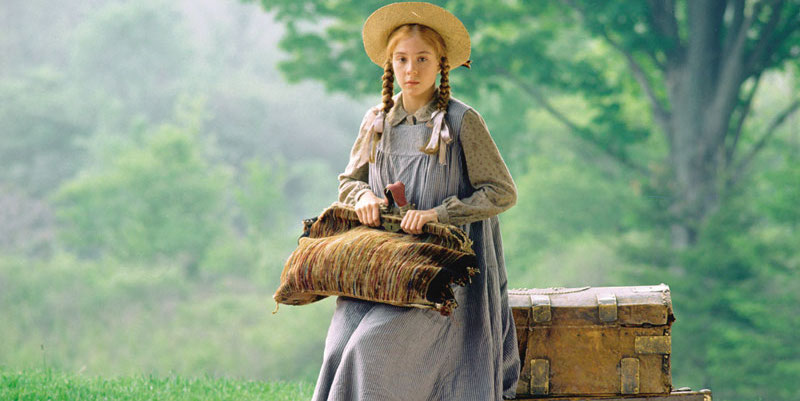Road to Avonlea: Amanda Parrish Morgan on The Transportive Intimacy of Reading and Long Drives
"The car, the book, the trip—all means of getting somewhere unknown together."
As the kind of girl who grew up more firmly rooted in the worlds of books than the world around me, I’m not sure how it is that I hadn’t read Anne of Green Gables before age 40. From my fellow book-lovers I’d heard all about Anne, of course—about her red hair and devotion to the E at the end of her name and the beauty of her Prince Edward Island home—but it wasn’t until I read the first book in the series aloud with my eight-year-old daughter that I came to fully understand her appeal. It’s not just that she’s a smart, quirky, red-headed, freckled, straw-hat-wearing girl from the Maritime Provinces (all major selling points); it’s also that she’s earnest and intense and fervent and dreamy and stubborn—things that I (and potentially I alone) consider to be my best qualities.
Because I had never read the Anne books as a girl, I brought L Maud Montgomery’s stories to my daughter, Thea, without the weight of nostalgia that I’d brought to our readings of The Chronicles of Narnia, From The Mixed Up Files of Mrs. Basil E. Frankweiler, or Mandy. We got to meet Anne together, each of us experiencing the tentative curiosity and skepticism that so often come with reading a new book, particularly one whose reputation looms so large, in parallel.
Thea is a voracious reader who, the summer we began Anne of Green Gables, had begun for the first time to travel back and forth between the world of early elementary school and adolescence. She’d finished the Ramona books long ago, but the stories of middle school friendship and crushes in the next section at the library didn’t always resonate. Her days were still most often marked by staging elaborate plays with her little brother and her devotion to a well-loved stuffed sheep named Baa. As I write this, she’s been debating if she wants her first day of school outfit to be the smocked floral dress she picked out a few weeks ago or the more “funky” outfit she laid out after reading a book on the principles of style.
I’d hoped that Anne might be a bridge between these worlds—older, even at the book’s beginning, than Ramona or Ivy and Bean but still, despite being orphaned and lonely, innocent in many of the same ways Thea is. Like Anne, Thea delights in the beauty of the world around her. Like Anne, she loves a good puff sleeve. Like Anne, Thea’s imagination is rich enough to sustain her through periods of solitude. Anne calls the people she meets who share a specific, if inarticulable, sensibility “kindred spirits,” which, for Thea and me both (perhaps for slightly different reasons), was exactly what Anne was.
*
My husband and I are both educators, and as our children have moved out of the phase of childhood that requires constant vigilance, I’ve started to wonder how our family might spin something magical from the summer flexibility our jobs grant us. This year, Nick and I each decided to take one-on-one trips with our two children. I took my six-year-old son, Simon, for two days at an amusement park where we rode biggest roller coaster six time in a row and ate ice cream twice each day. For Thea, I planned a trip to Prince Edward Island.
Even from the northeastern United States, getting to PEI is a significant logistical undertaking. We could have flown or taken a train to Montreal and then flown to the island’s airport in Charlottetown. But, because PEI is largely rural we’d have needed to rent a car once there in order to see all the Anne sights on our list: the red sand beaches, the L. Maud Montgomery heritage site, a recreation of Anne’s green-gabled house, the Anne & Gilbert musical, the tractor-pulled carriage ride across the real farm on which the Cuthberts’ fictional one was modeled and the inspiration for what Anne calls “The Lake of Shining Waters,” the reproduction of Avonlea village, and the many shops where one can buy a straw hat with two red braids attached. In the end we decided to drive.
At many times of transition, it’s been long drives have helped me navigate uncertainty, grief, or anticipation. When I left home for college, the manageable pace of driving away, first down our steep driveway, then left out of our cul-de-sac and onto the Merritt Parkway, and finally accelerating into the 800 miles between Connecticut and Chicago made leaving home for the first time feel less daunting. That drive became one I did myself a few times each year, always as one semester was ending or a new one beginning, and with it the attendant feelings of wistfulness or hope for a fresh start. One summer in my twenties, struggling with burnout as a high school teacher, I drove meanderingly from Connecticut to DC to Arkansas to Kansas to New Mexico to Arizona to Colorado to South Dakota to Minnesota to Chicago and back as a way to put physical distance between myself and the school year that had ended. I returned, just as I’d sensed I would, ready to teach again in September. When I was pregnant with Thea, Nick and I drove to Western Montana in what we rightly imagined would be our last long road trip for some years, as a way both to savor and to close the door on the years of child-free travel we’d enjoyed as a couple.
*
From our home in Fairfield County, Thea and I drove through Massachusetts and into Portsmouth, New Hampshire where we stopped for baked goods, books, and a walk across the bridge into Maine. We spent our first night at a farm a few hours north outside the small town of Hallowell, Maine, and early the next morning drove north and east toward the Canadian border.
In Saint Stephen, Canada, the border agent looked at our passports and asked about our plans. I told him we were going to see the “Anne of Green Gables sights” thinking for some reason—incorrectly I realized right away—that this might be something he heard often at his booth five hours from the closest part of Prince Edward Island.
At many times of transition, it’s been long drives have helped me navigate uncertainty, grief, or anticipation.What he wanted to know was not what places in the books we were most excited to visit, but if I had written permission from Nick to take Thea out of the country. Maybe, he offered, we had a text message from Nick saying something like “have fun in Canada?” But, no—what we had were text messages of me saying things like “it’s hailing here!” the night before in Maine, and then a picture of Simon grinning in a Red Sox hat.
“Well, then,” the kindly border agent said, somewhat apologetically, “you’d better pull up and park over there and give him a call.” Inside, I put Nick on speaker phone while he chatted to a different agent behind the desk who flipped through our passports and sent us on our way.
Because there is no custody dispute—or custody arrangement at all since the four of us live together—I had not anticipated the vaguely illicit feeling I might have as we left the country, but I recognized it at once. It was like the feeling I used to get when my high school best friend and I called ourselves out sick from school and drove aimlessly around Connecticut backroads drinking milkshakes or hot chocolate, depending on the season. We weren’t doing anything dangerous or even really anything our parents would disapprove of (we were good students and never tried to hide our truancy from them), but it was safely removed—yet in proximity to–escape. This quaint and friendly checkpoint between the U.S. and Canada and the permission crossing it required spoke to a particular aspect of what I love about driving: the power to really get somewhere, really do something, with the mundane equipment of my everyday life, even if where we were going and what we were doing were sanctioned by anyone who might have reason to object to the journey.
*
We crossed into Prince Edward Island over the 200 foot high, eight-mile long Confederation Bridge. As road signs indicated the bridge’s approach, Thea fell asleep in the back seat, so I was free to let out an anguished gasp at the sight of it without frightening her. If I’d read before our trip that the bridge, one lane in each direction, was that high and that long, the numbers had been meaningless abstractions. I’m not a nervous driver, not particularly afraid of heights, and as someone who lives in a coastal suburb of a city whose boroughs are divided by rivers and bays, I drive over bridges all the time. This bridge, though, required mantras and affirmations like those I’d used during childbirth or in the final miles of a marathon. The only way out is through (or, I guess, more aptly, over) and eyes straight ahead. Do not, I commanded myself, google “how many people dead confederation bridge” when you get to your hotel tonight. Do not.
Reading a book aloud, especially to a child, means getting on that frigate together, being passengers in the same car, not just with a character with whom we might feel like kindred spirits, but with each other.The bridge and the terror it induced seemed, somehow, to make the rolling hills of PEI and the sweet reconstructions of Anne’s world all the more bucolic. We drove for an hour across the island, checked into our inn (called Kindred Spirits!) and went right to dinner in Avonlea—a newly constructed tribute village approximating the town where Anne moves at the beginning of the first book in the series. I’m smug enough to find Disney World cheesy and unappealing, but a village devoted to a red-haired orphan in a straw hat that can only be reached by daunting bridge, multiple-leg air travel or infrequent ferry? Magical.
In the two days we spent on the island, I tried to say yes to Thea whenever I could. She’s a rule-follower at heart, and so this was not hard. We returned at least once each day to pretend Avonlea, swam in the hotel pool, ate PEI ice cream, bought one of the braids-attached straw hats, had dinner at a fancy Italian restaurant before the Anne & Gilbert musical, and on our last morning in town, did the thing I told Thea was the only item on my bucket list and explored the red sand beaches along the waters of the North Atlantic’s frigid Gulf of St. Lawrence. Before we crossed back over the Northumberland Straight onto New Brunswick, I explained as calmly as I could to Thea that I needed her to be quiet while we drove so that I could focus. Other than those long minutes on the bridge, though, we talked for the 746 miles home. We talked about Anne and Gilbert’s marriage—did she love him or not? And if she did, why did she start to love him when she hadn’t before? In the musical Anne’s love for Gilbert comes on quickly, but in the books—the second and third in the series, which we haven’t read yet—we had to assume there was a little more context. We sang our favorite song from the performance and speculated about what would have happened if two actors with the same understudy had gotten sick on the same night. We ranked the ice cream cones we’d had, reviewed elementary school drama and why listened to a podcast about why some people have food allergies and got excited for how wild it would be to see the northern terminus of I-95, that congested scourge of our Connecticut lives.
Often parents of older children tell me that they have their most important conversations in the car, its in-betweenness allowing or even requiring a kind of intimacy that’s easily escapable in the world outside its steel walls–even in a shared home.
When after six hours of driving and just over the border back into the U.S. on an otherwise-deserted I-95, conversation began to slow except for the comments we made about the places we were passing by. We talked about all the things I love to think about when I drive: where should we stop for dinner and what should we order? What history was behind the shuttered opera house? What would it be like to live here? Or here? What would it be like to be someone else? Where else might we take ourselves? Who else might we be?
In the final days before fourth grade, Thea is on the cusp not just of books for children and books for young adults or smocked dresses and funky fashion, but also about to step over and out of a threshold of a certain kind of intimacy that’s until now defined parenting. In the earliest years the intimacy was bodily—nursing, bathing, swaddling, rocking—but for many years after babyhood, the stories and the worlds they might carry her to were necessarily limited by what I chose to read her.
I once worked with a woman who had a tattoo of Emily Dickinson’s line “There is no Frigate like a Book.” And, in fact, it was from this poem (actually, from her tattoo) that I learned of the existence of frigates themselves, small warships capable of traveling at high speeds. Reading a book aloud, especially to a child, means getting on that frigate together, being passengers in the same car, not just with a character with whom we might feel like kindred spirits, but with each other. The car, the book, the trip—all means of getting somewhere unknown together.




















